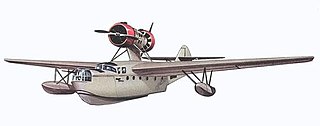
The Yakovlev Yak-24 is a Soviet twin-engine, tandem rotor, transport helicopter developed by Yakovlev in the 1950s. The Yak-24 saw limited use in the Soviet Air Force, and the exact number produced and duration of service are unknown due to inconsistencies in data.

The Yakovlev Yak-15 was a first-generation Soviet turbojet fighter developed by the Yakovlev design bureau (OKB) immediately after World War II. The main fuselage was that of Yakovlev Yak-3 piston-engine fighter modified to mount a reverse-engineered German Junkers Jumo 004 engine. The Yak-15 and the Swedish Saab 21R were the only two jets to be successfully converted from piston-power to enter production. 280 aircraft were built in 1947. Although nominally a fighter, it was mainly used to qualify piston-engine-experienced pilots to fly jets.

The Mikoyan-Gurevich DIS was a prototype Soviet heavy fighter of World War II, envisioned to serve primarily in the escort fighter role. The service designation MiG-5 was reserved for the production version of the aircraft. Competing designs in the USSR included the Grushin Gr-1, Polikarpov TIS and Tairov Ta-3.

The Kamov Ka-10 was a Soviet single-seat observation helicopter that first flew in 1949.

The Ilyushin Il-30 was a Soviet turbojet-powered tactical bomber designed as a higher-performance, swept wing version of the Ilyushin Il-28, in the late 1940s. Its thin wing and engine nacelles necessitated the use of tandem landing gear, the first Soviet aircraft to do so. It was apparently canceled before the prototype made its first flight, although sources disagree with this.

The Yakovlev Yak-30 was an experimental Soviet interceptor from the late 1940s. Derived from the Yak-25, from which it differed primarily in having wings sweptback 35° at quarter chord, the Yak-30 retained the fuselage, tail surfaces and undercarriage of the earlier fighter.
Bratukhin, or OKB-3, was a Soviet aircraft design bureau created in 1940 from within TsAGI to develop helicopters. Headed by Ivan Pavlovich Bratukhin, the bureau built several experimental helicopters over the next decade. Each model had the same basic design of two rotors with separate engines carried on the ends of outriggers to each side of the fuselage. The bureau was dissolved in 1951.

The Chyetverikov ARK-3 was a multi-role flying boat designed for Arctic operations that was built in the Soviet Union from 1933. It featured a conventional flying boat hull, with high cantilever wings equipped with floats at mid-span. The two piston engines were mounted in tractor-pusher fashion on a pylon above the fuselage.
The Yakovlev EG, also commonly known as the Yak-M11FR-1 and Sh (Shootka), was an experimental aircraft with coaxial rotors. The prototype was first flown by V.V. Tezavrovsky in December 1947.

The Lavochkin La-200 was a two-seater, swept winged, night/all-weather jet interceptor designed and manufactured by the Soviet Union's Lavochkin Design Bureau from 1948.
The Alekseyev I-21 was a Soviet twin-engined jet fighter, built in the late 1940s. Two prototypes were constructed with the designation of I-211, of which one was converted into the I-215 with more powerful engines. A third aircraft was built to evaluate the bicycle landing gear arrangement for use in other aircraft. The fighter was not accepted for production as it was inferior to the swept-wing fighters like the Mikoyan-Gurevich MiG-15.
The Nikitin NV-2 was a single-seat sporting aircraft produced in the USSR from 1935.
The Nikitin-Schyevchyenko IS series,, were single seat polymorphic fighters designed and produced in the USSR from 1938.

The Polikarpov TIS was a heavily armed Soviet heavy fighter designed during the early 1940s. Competing contemporaneous designs in the USSR included the Grushin Gr-1, Mikoyan-Gurevich DIS and Tairov Ta-3.

The Yakovlev Yak-140 was a Soviet prototype lightweight supersonic fighter developed during the 1950s. The prototype was completed in 1954, but it was denied authorization to enter flight testing and the program was cancelled in 1956.

The Polikarpov NB was a Soviet twin-engined bomber designed during World War II. Only a single prototype had been built before the program was terminated upon the death of Nikolai Nikolaevich Polikarpov, the head of the aircraft's design bureau, in 1944.
The Bratukhin B-5 was a prototype Soviet twin-rotor transport helicopter designed by the Bratukhin aircraft design bureau.
The Ilyushin DB-4 or TsKB-56 was a Soviet twin-engined bomber aircraft of the early 1940s. It was a development of the Ilyushin DB-3 and was intended as a replacement for the earlier aircraft, but only two prototypes were built; engine problems and the need to concentrate production on existing types following the German invasion of the Soviet Union in June 1941 meant that no more examples were built.

The Yakovlev AIR-7 was a prototype Soviet high performance light aircraft of the 1930s. It was a two-seat single-engined monoplane, which demonstrated excellent performance during testing. After the prototype almost crashed as a result of flutter, its designer, Alexander Sergeyevich Yakovlev suffered temporary disgrace and no production followed.
The Tupolev ANT-41 was a prototype Soviet twin-engined torpedo-bomber of the 1930s. A single prototype was built, which was destroyed in a crash. No production followed, with the Ilyushin DB-3 serving as a torpedo bomber instead.












